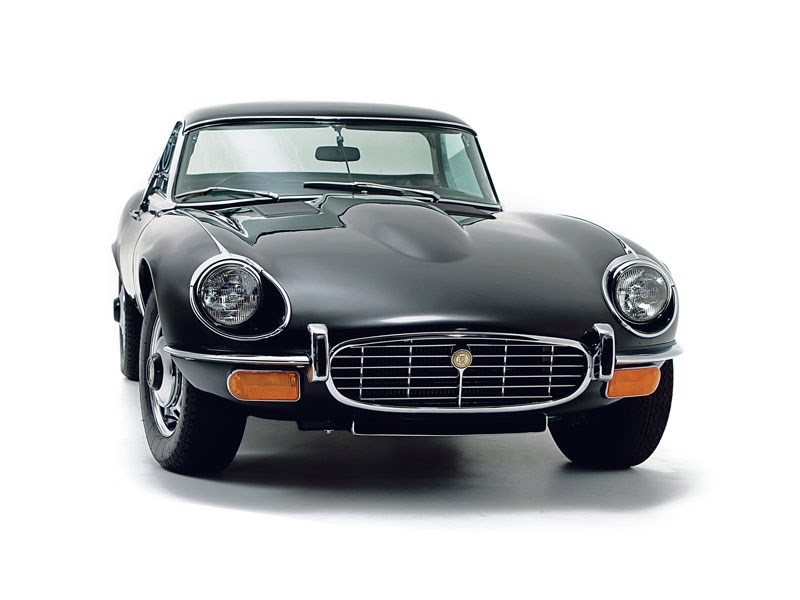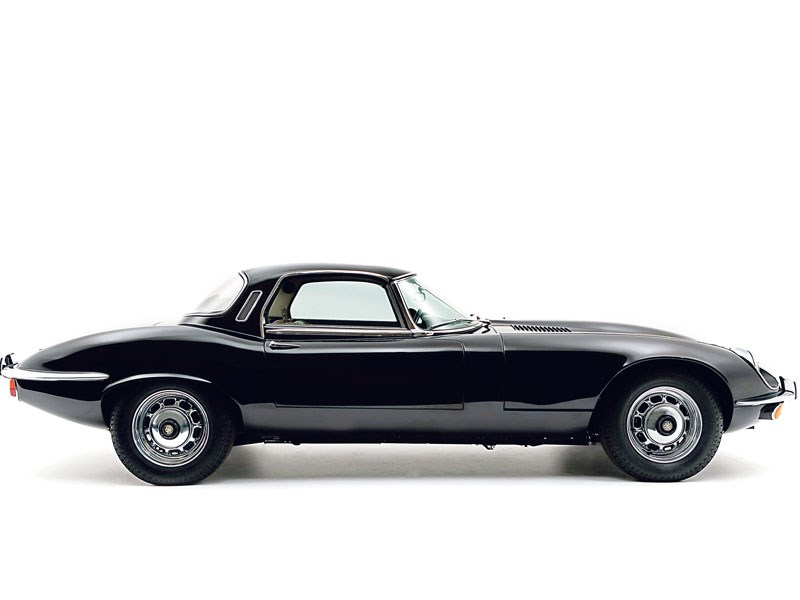Dropping a V12 engine into the E-type helped it evolve from a pure sports car into a grand tourer. Here's how to ensure you buy a good one...
If you ask enthusiasts to pick their favourite breed of Jaguar E-type, chances are the Series 3 wouldn't be chosen by many. The E-type was very much a child of the 1960s, but the sleek and stylish star developed middle age spread for the Series 3, 10 years after its debut. Wheelarches flared, extra chrome was added, the almost delicate-looking front grille was enlarged to feature egg-crate slats, disc wheels replaced wires and only longer wheelbase 2+2 roadsters and coupes were available. The purity of the original was replaced by a fussiness that hinted at Jaguar doing all the nips and tucks it could to try to keep the car going until a successor could be found.
However, there was a big bonus with the S3 that you didn't get with any of its predecessors. And that was what was under its long, tapering bonnet. Jaguar had developed a rather glorious 5.3-litre V12 engine intended for the XJ12. But fitting it in the E-type first was a handy way of proving its reliability. With 272bhp on tap, it was a wonderful way of guiding the E-type through its twilight years. And although the V12-powered machines lacked the frantic charisma of the earlier six-cylinder cars, they now had a sophisticated refinement instead that made them excellent GT cruisers. Maybe an earlier E-type could run rings around them in a shorter cross-country blast, but when it came to charging across entire countries on motorways, an S3 was by far the superior choice.
The V12 model stayed in production for just three- and-a-half years until supplanted by the XJ-S. During that time, 14,983 examples were built, with most of the cars going to the United States. It was bedevilled by increasing legislation and a fuel crisis that suddenly made cars unable to haul their fuel consumption out of the teens very unattractive. The final 50 made were finished in black and sported a special numbered dashboard plaque bearing the signature of Sir William Lyons. By then, he'd retired as well... truly the end of two great Jaguar eras.
VITAL STATISTICS
JAGUAR E-TYPE SERIES 3
Engine 5343cc/V12/SOHC
Power (bhp@rpm) 272bhp@5850rpm
Torque (lb ft@rpm) 304lb ft@3600rpm
Top speed 146mp
0-60mph 6.4sec
Consumption 15mpg
WHAT TO LOOK FOR
BODYWORK & CHASSIS
It costs a lot to restore an E-type, so sometimes jobs can be skimped on or skipped completely. Thus checking everything is vital. As a barometer, look behind the fuel filler flap. If it's grotty on a car that has supposedly been sorted, then other areas may be dodgy too.
Check panel gaps all around - especially where the bonnet meets the bulkhead, the trickiest spot to align. Areas to check for corrosion include the bootlids on roadsters and the door bottoms on all types, due to blocked drainholes. Check in all the boot for collected water. The tubular frame in front of the bulkhead that supports the engine also rusts or cracks and is a mega job to rectify. Bonnet noses, sills, the rear wing edges and below the back bumper are also vulnerable. Underneath, examine the three strengthening ribs.
Look for pitting of Mazak items such as door handles. And thoroughly check the hood of a convertible for marks, splits and easy operation.
ENGINE
The V12 is a tough old thing and probably much less stressed now than when E-types were more enthusiastically driven. Look and listen for overheating and harshness; the block and heads may have been warped. Make sure the thermostatic cooling fan cuts in as it should. On the oil pressure gauge, check for 0lb or higher at 3500rpm. Oil leaks are quite common - if it's from the rear chrankshaft seal though, it's a very pricey job to put right.
A rattle from the front of the engine is likely to be a worn timing chain, especially if is happens when revving or the overrun. this can strike cars after every 35,000 miles or so.
Check all the hoses under the bonnet - there are a mind boggling 20 of them. And while you're at it, also look at the fuel lines, which go brittle as a result of heat. Carburettors can be difficult to tune properly, especially if their diaphragms have perished.
RUNNING GEAR
There's no greater sign that the S3 had metamorphosed into a GT than in the fact that most V12 E-types were fitted with an automatic Borg-Warner Model 12 three-speed automatic transmission. It's pretty tough but look out for jerkiness or slipping, pointing to a service or even a full overhaul being needed. The manual cars can be affected by weak synchromesh on second and third and be concerned if you have real difficulty selecting gears when the gearbox is cold.
On all types, be wary of vibrations, clonks and whining from the differentials and driveshaft during your test drive.
BRAKES
The steering - which is rack and pinion - should feel sharp. Significant play points to worn column universal joints. On the rear suspension, the lower hub pivots have to be greased. If it's been missed you may hear creaking - which means they're corroded and potentially on the way to seizing. If you can jack the car up, check for play at the wheels. The rear ones should have some - if not, then it suggests the bearings have been over-tightened and will wear out soon. There should be less play with the front wheels though. If there's quite a bit, it signals worn bearings or lower wishbone balljoints.
A car where it feels like the back wheels are also steering probbly has worn or broken axle cage mountings. Steel wheels were standard, but wire wheels may have been fitted. Check them for damaged spokes and worn splines.
Brakes can be affected by any leaking oil from the differential getting on the in-board rear ones. The differential needs to be taken out to sort this, which is very involved. Test the handbrake - its self-adusting mechanism needs to be greased and may seize if it isn't.
INTERIOR
Fortunately, the interior isn't something you need to worry about, because practically everything is available. But it just costs quite a bit. Don't under-estimate the price of putting right damaged leather.
Electrical issues are often down to poor earths or bittle wiring, although DIY fiddling can also cause trouble. However, heater motors can stop working - make sure you try it out when you take an S3 for a test drive.
OUR VERDICT
The last of the E-types isn’t everybody’s cup of tea, because it’s set up as a refined and fast grand tourer, not a sports car. Some people argue that the V12 is too refined for the car and seems much more at home in an XJ12 saloon. However, if you love the E-type shape but find the six-cylinder engines a bit too aggressively sporty, then the Series 3 is for you.
There are compromises in the soft-top, such as a foul between the headrests and the hood mechanism when the latter is raised. The long wheelbase also did nothing for the proportions that had worked so well on the earlier cars.
Buying cheaply is potentially risky because of the costs of top-quality repairs and restoration. On the other hand, would you want to drive a concours car every day? We reckon the sensible choice is a mid-priced car that’s been carefully checked by a reputable specialist.
The E-type was already 10 years old and firmly established as a legend when the final Series 3 models were launched in 1971. Powered by the brand new V12 engine that would later be fitted in the Jaguar saloons, both the roadster and fixed-head models were on the longer wheelbase introduced for the 2+2 models. So although they looked like the sports car we all knew and loved, they also had some distinctive differences.
One of those differences was the significantly softer suspension, which taken together with the extra length, made the Series 3s more like grand tourers than the earlier E-types had been. Yet despite this slightly more staid image, the astonishing V12 engine brought its own glamour. Although sales of these thirsty big cats slowed following the 1973 oil crisis, Jaguar kept turning them out until 1975, when the XJ-S took over.
Altogether, there were 15,287 built, of which 7990 were roadsters and 7297 fixed-heads. The last 50 all carried a dashboard plaque bearing the signature of Jaguar’s founder, Sir William Lyons.



